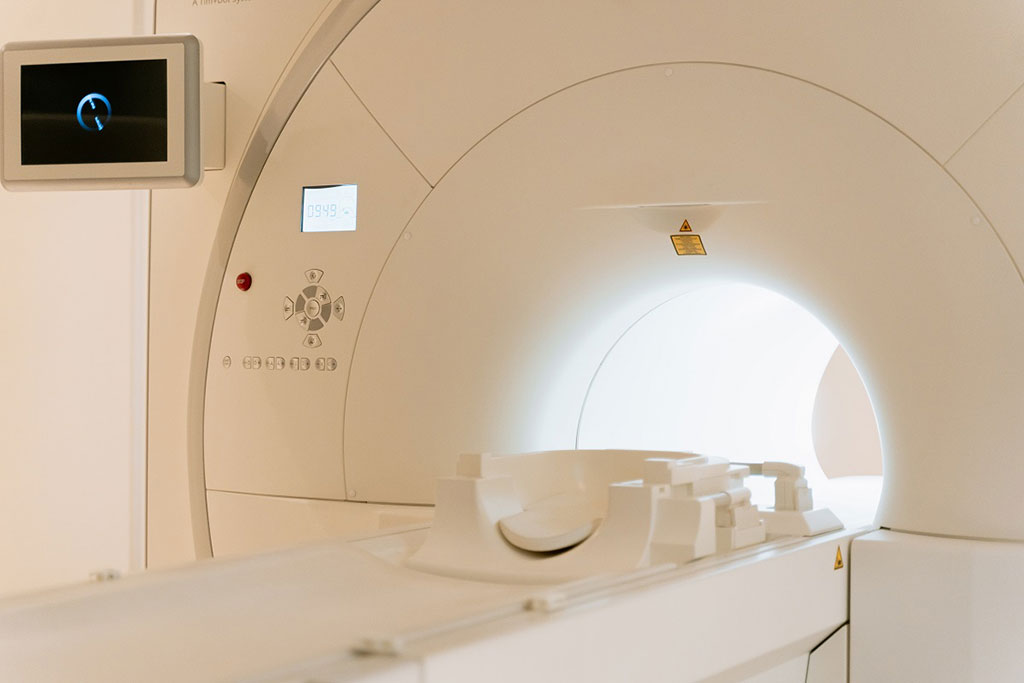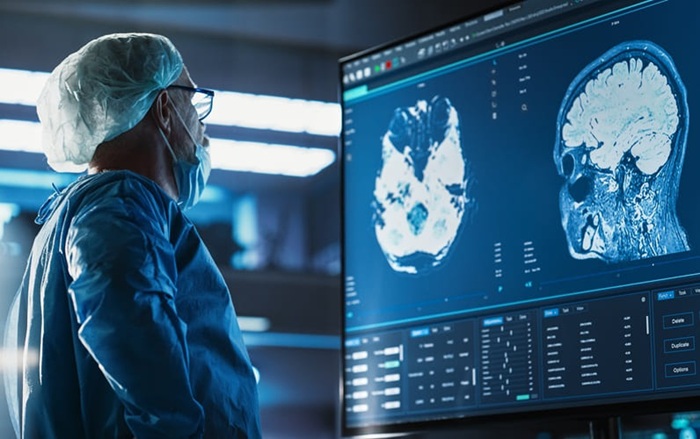AI in Radiology Market Driven by Growing Adoption of Machine Learning Tools in Broad Spectrum of Imaging Applications
|
By MedImaging International staff writers Posted on 10 Nov 2021 |

Artificial intelligence (AI) tools and technologies have been making enormous impacts on various aspects of healthcare. The use of AI algorithms in medical image analysis field has made astounding progress. Particularly deep learning has made incessant inroads in radiology practice. The major consumer proposition for companies in the AI in radiology market stems from the exceptional capabilities of AI tools in recognizing complex patterns in the imaging data.
These are the latest findings of Transparency Market Research (Albany NY, USA), a next-generation market intelligence provider.
The exponential rise of clinical, molecular, imaging, and genomic data has extended the canvas for the need for utilization of advanced IT and data processing tools for assessments of radiographic characteristics, and enrich the work of radiologists. As a result, radiomics has made striking strides in recent years. The utilization of AI in radiology continues to expand, as is evident in the rise in the growing adoption of machine learning tools in broad spectrum of imaging applications, driving the AI in radiology market. Some of the key applications of AI in imaging are risk assessment, diagnosis, identification, prognosis, evaluation of risk of reoccurrence, and therapy response. Several clinically useful AI tools have been developed to meet these applications in AI in radiology market.
One of the key areas with massive potential revenues is oncology. Specifically, AI algorithms are used in a number of thoracic imaging tasks including such as lung nodules assessment for identifying whether these are benign or malignant, pneumonia detection, or estimation of diffuse lung diseases. The past few years have seen rapid technological advancements in deep learning, raising the standard of AI, which has expanded the horizon of the AI in radiology market. A number of anomalies have been found to open to detection for radiologists. Deep learning integrated with magnetic resonance imaging (MRI) has been found to make time-based assessment of the histological analysis of breast cancer. Images from other modalities are also open to a reliable scrutiny by AI methods; examples are computed tomography (CT) and positron emission tomography (PET). A case in point is the growing clinical potential of use of ML tools in pancreatic cancer analysis in CT and MRI.
Some of the end-use areas in the AI in radiology market are abdominal and pelvic imaging, colonoscopy, mammography, and brain imaging. The areas of applications continue to expand with the growing awareness about the unique capabilities of AI in radiomics. A case in point is the emerging prospects in chest computed radiography. The use cases of AI in DNA and RNA sequencing is anticipated to unlock an incredible avenue for players in the AI in the radiology market. AI tools have become a friend for radiologists, and in the near future will increasingly complement diagnosis and clinical care.
Players in the AI in radiology market are constantly striving to offer solutions that bridge the gap between training and applications in real-world populations. Hospitals also simultaneously need to upskill their healthcare staff in using complex AI systems. In effect, this is one of the key focus areas for AI tools developers in the AI in radiology market to reduce the chances of errors and prevent algorithmic biases. Another area that is replete with opportunities is ethical aspects of AI. Human designers and operators should work collaboratively to develop next-gen AI for radiology applications. The aspect should be at the crux of new product development, opines experts, and the factor will also massively shape the competitive dynamics of the AI in radiology market.
Geographically, North America is a highly lucrative AI in radiology market. Its growth has been fueled by massive advancements in deep learning tools. The healthcare industry has been increasingly benefitted from the growing practical implications of AI in radiomics. Asia Pacific is being viewed as an emerging AI in radiology market in recent years. The growing technical expertise of leveraging AI for patient well-being will propel the growth of this regional market, going forward.
Related Links:
Transparency Market Research
Latest Industry News News
- GE HealthCare and NVIDIA Collaboration to Reimagine Diagnostic Imaging
- Patient-Specific 3D-Printed Phantoms Transform CT Imaging
- Siemens and Sectra Collaborate on Enhancing Radiology Workflows
- Bracco Diagnostics and ColoWatch Partner to Expand Availability CRC Screening Tests Using Virtual Colonoscopy
- Mindray Partners with TeleRay to Streamline Ultrasound Delivery
- Philips and Medtronic Partner on Stroke Care
- Siemens and Medtronic Enter into Global Partnership for Advancing Spine Care Imaging Technologies
- RSNA 2024 Technical Exhibits to Showcase Latest Advances in Radiology
- Bracco Collaborates with Arrayus on Microbubble-Assisted Focused Ultrasound Therapy for Pancreatic Cancer
- Innovative Collaboration to Enhance Ischemic Stroke Detection and Elevate Standards in Diagnostic Imaging
- RSNA 2024 Registration Opens
- Microsoft collaborates with Leading Academic Medical Systems to Advance AI in Medical Imaging
- GE HealthCare Acquires Intelligent Ultrasound Group’s Clinical Artificial Intelligence Business
- Bayer and Rad AI Collaborate on Expanding Use of Cutting Edge AI Radiology Operational Solutions
- Polish Med-Tech Company BrainScan to Expand Extensively into Foreign Markets
- Hologic Acquires UK-Based Breast Surgical Guidance Company Endomagnetics Ltd.
Channels
Radiography
view channel
X-Ray Breakthrough Captures Three Image-Contrast Types in Single Shot
Detecting early-stage cancer or subtle changes deep inside tissues has long challenged conventional X-ray systems, which rely only on how structures absorb radiation. This limitation keeps many microstructural... Read more
AI Generates Future Knee X-Rays to Predict Osteoarthritis Progression Risk
Osteoarthritis, a degenerative joint disease affecting over 500 million people worldwide, is the leading cause of disability among older adults. Current diagnostic tools allow doctors to assess damage... Read moreMRI
view channel
Novel Imaging Approach to Improve Treatment for Spinal Cord Injuries
Vascular dysfunction in the spinal cord contributes to multiple neurological conditions, including traumatic injuries and degenerative cervical myelopathy, where reduced blood flow can lead to progressive... Read more
AI-Assisted Model Enhances MRI Heart Scans
A cardiac MRI can reveal critical information about the heart’s function and any abnormalities, but traditional scans take 30 to 90 minutes and often suffer from poor image quality due to patient movement.... Read more
AI Model Outperforms Doctors at Identifying Patients Most At-Risk of Cardiac Arrest
Hypertrophic cardiomyopathy is one of the most common inherited heart conditions and a leading cause of sudden cardiac death in young individuals and athletes. While many patients live normal lives, some... Read moreUltrasound
view channel
Wearable Ultrasound Imaging System to Enable Real-Time Disease Monitoring
Chronic conditions such as hypertension and heart failure require close monitoring, yet today’s ultrasound imaging is largely confined to hospitals and short, episodic scans. This reactive model limits... Read more
Ultrasound Technique Visualizes Deep Blood Vessels in 3D Without Contrast Agents
Producing clear 3D images of deep blood vessels has long been difficult without relying on contrast agents, CT scans, or MRI. Standard ultrasound typically provides only 2D cross-sections, limiting clinicians’... Read moreNuclear Medicine
view channel
PET Imaging of Inflammation Predicts Recovery and Guides Therapy After Heart Attack
Acute myocardial infarction can trigger lasting heart damage, yet clinicians still lack reliable tools to identify which patients will regain function and which may develop heart failure.... Read more
Radiotheranostic Approach Detects, Kills and Reprograms Aggressive Cancers
Aggressive cancers such as osteosarcoma and glioblastoma often resist standard therapies, thrive in hostile tumor environments, and recur despite surgery, radiation, or chemotherapy. These tumors also... Read more
New Imaging Solution Improves Survival for Patients with Recurring Prostate Cancer
Detecting recurrent prostate cancer remains one of the most difficult challenges in oncology, as standard imaging methods such as bone scans and CT scans often fail to accurately locate small or early-stage tumors.... Read moreGeneral/Advanced Imaging
view channel
New Algorithm Dramatically Speeds Up Stroke Detection Scans
When patients arrive at emergency rooms with stroke symptoms, clinicians must rapidly determine whether the cause is a blood clot or a brain bleed, as treatment decisions depend on this distinction.... Read more
3D Scanning Approach Enables Ultra-Precise Brain Surgery
Precise navigation is critical in neurosurgery, yet even small alignment errors can affect outcomes when operating deep within the brain. A new 3D surface-scanning approach now provides a radiation-free... Read moreImaging IT
view channel
New Google Cloud Medical Imaging Suite Makes Imaging Healthcare Data More Accessible
Medical imaging is a critical tool used to diagnose patients, and there are billions of medical images scanned globally each year. Imaging data accounts for about 90% of all healthcare data1 and, until... Read more





















